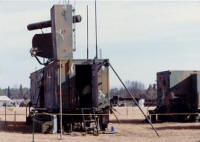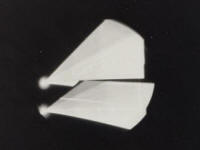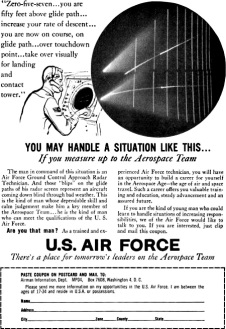USAF Recruitment Advertisement - Precision Approach Radar
|
|
Equipment Trailer nearest in photo, Maintenance trailer inline and connected to the rear, RAPCON separate and to the right. ASR & IFF antennas toward center of trailer, PAR Elevation antenna nearest. (circa 1979-82) This is cool. I saw a U.S. Air Force recruitment advertisement in a 1960 edition of Popular Electronics magazine pitching careers as radar operators (air traffic control) and technicians (maintenance). The picture has the dual-display glide path and elevation sweeps from the MPN/13/14 radar system that I worked on in the late 1970s - early 1980s. A photo I took circa 1980 of our unit based at Robins AFB, Georgia, is shown below. The precision approach radar (PAR) operated at x-band (10 GHz) with an operational range of 10 nautical miles. B&W photo of PAR display showing Elevation display at top and Azimuth display on bottom. Yes, it is in dire need of alignment. The azimuth and elevation antennas were mechanically swept with motors that changed the geometry of a waveguide having dipole stubs along its length. The entire PAR system was built with vacuum tubes and chassis using point-to-point wiring. Sweep patterns on the CRT were aligned using an iterative procedure to adjust linearity, x-y position, outline, size, course line and glide slope centerlines, etc. It could be quite frustrating until you got the hang of it. Unlike the airport surveillance radar (ASR) portion of the system which was used for flight path vectoring and aircraft separation while at cruising and transition altitudes, the PAR was used to guide aircraft down nearly to the ground in "blind landings." Air traffic controllers were in constant contact with the pilots giving them corrections as needed to stay centered on the line. I don't recall the decision height for USAF airplanes, but for civilian aviation in Instrument Flight Rules (IFR), it can be as low as 50 feet - that is not much time to stop a landing approach and transition to a missed approach maneuver. "Zero-five-seven... you are fifty feet above glide path... increase your rate of descent... you are now on course, on glide path... over touchdown point...take over visually for landing and contact tower." YOU MAY HANDLE A SITUATION LIKE THIS... If you measure up to the Aerospace Team The man in command of this situation is an Air Force Ground Control Approach Radar Technician. And those "blips" on the glide paths of his radar screen represent an aircraft coming down blind through bad weather. This is the kind of man whose dependable skill and calm judgment make him a key member of the Aerospace Team... he is the kind of man who can meet the qualifications of the U. S. Air Force. Are you that man? As trained and experienced Air Force technician, you will have an opportunity to build a career for yourself in the Aerospace Age - the age of air and space travel. Such a career offers you valuable training and education, steady advancement and an assured future. If you are the kind of young man who could learn to handle situations of increasing responsibilities, we of the Air Force would like to talk to you. If you are interested, just clip and mail this coupon. U.S. AIR FORCE There's a place for tomorrow's leaders on the Aerospace Team
Posted May 22, 2023 |
|



